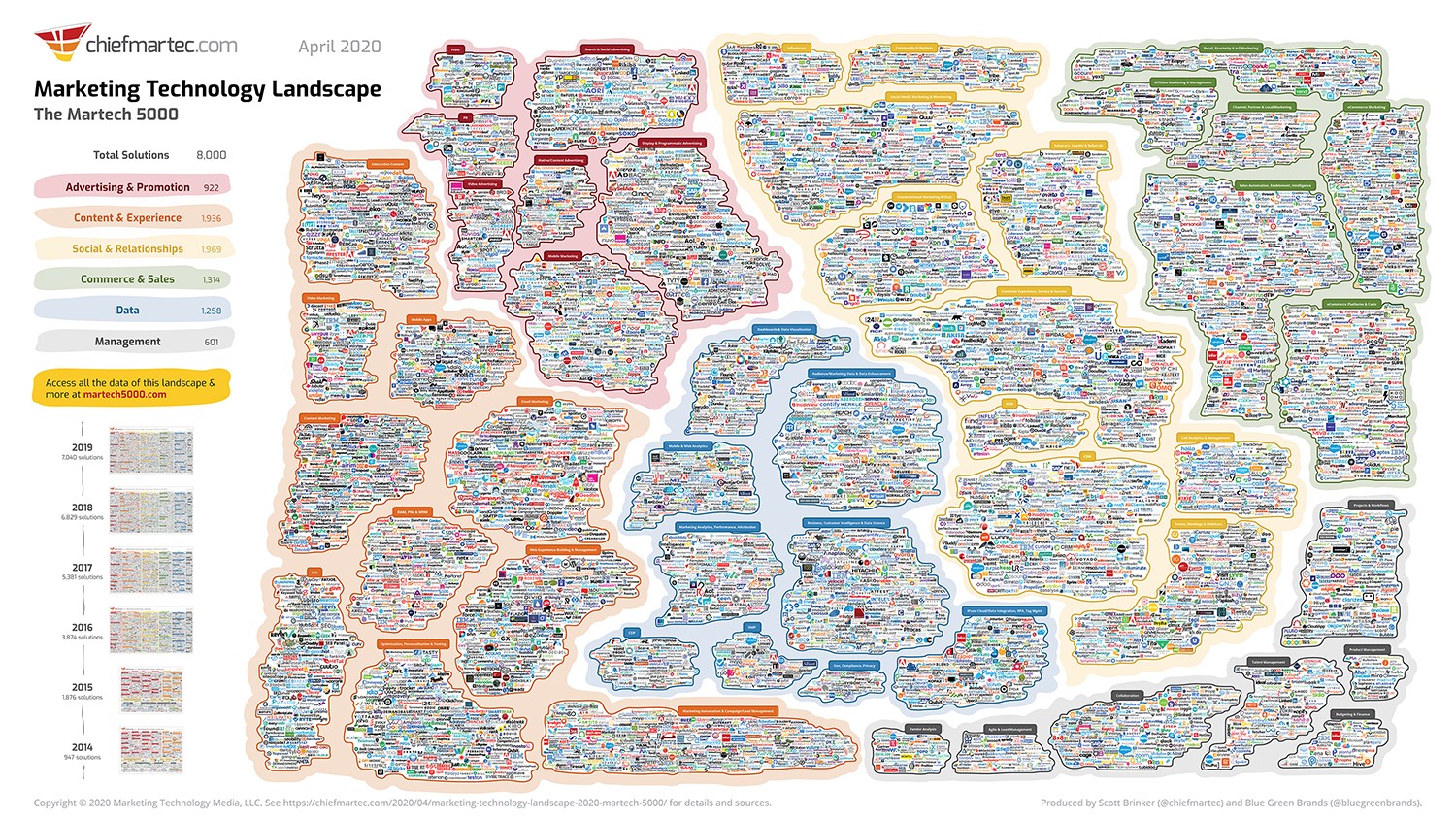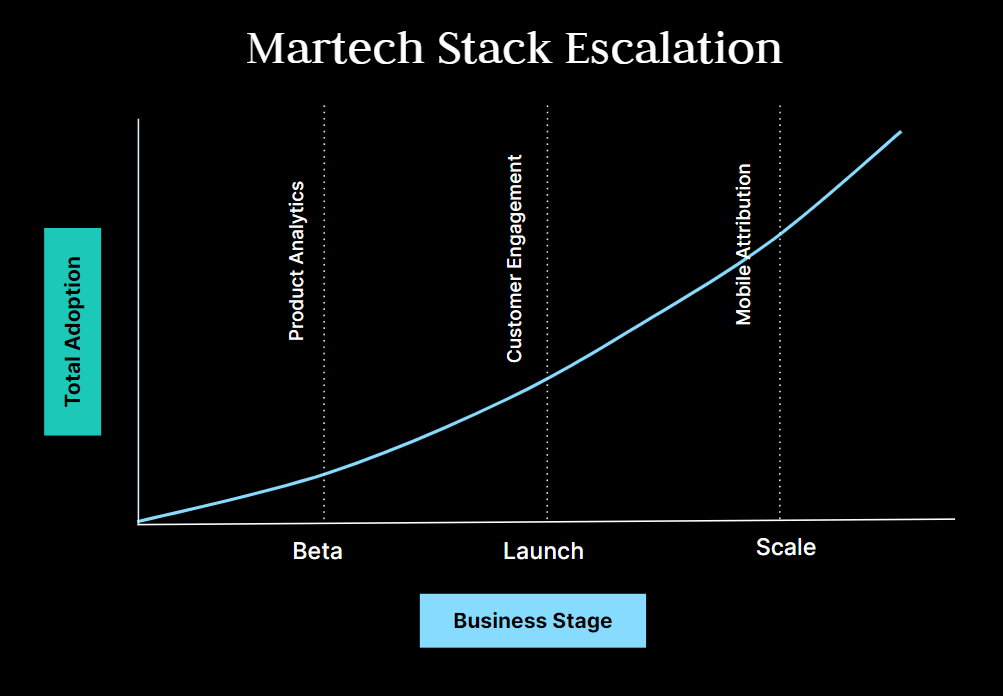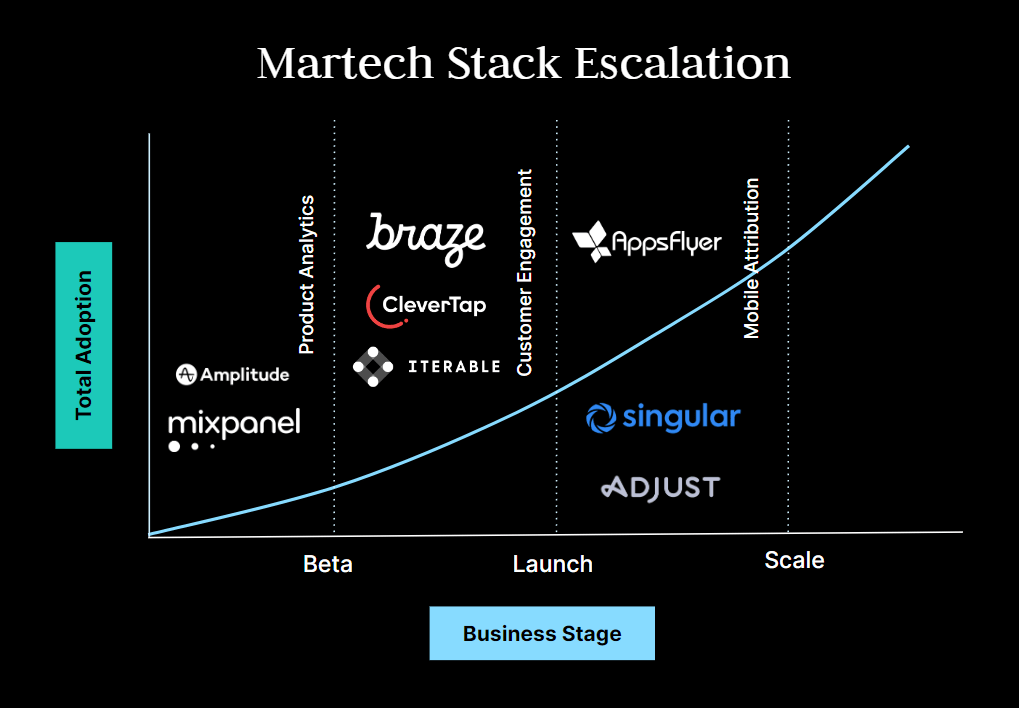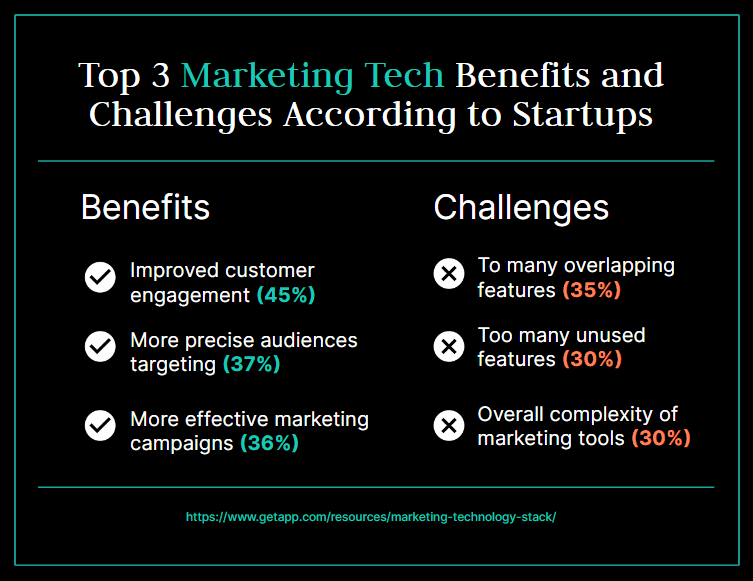BLOG | May 17, 2024
How to choose wisely your startup Martech stack.
The Boot Theory of Martech.
Summary
“You get what you pay for…”
The “Boots” theory emphasizes spending wisely rather than low quality/scale. By choosing a scalable martech stack, startups avoid costly system transitions during growth, saving money and building a sustainable infrastructure for the future.
A few more details about this theory, and then you will rapidly understand why we bring this thought to the process of choosing your Martech stack to your startup.
The “Boots” Theory of Socioeconomic Inequality, popularly known as the boots theory, posits that individuals in poverty are compelled to purchase low-quality products, necessitating frequent replacements and ultimately costing more over time than higher-quality alternatives. Coined by English fantasy author Sir Terry Pratchett in his 1993 Discworld novel “Men at Arms,” the theory is exemplified by Sam Vimes, captain of the Ankh-Morpork City Watch, through a discussion on boots.
Vimes contemplated that the affluent maintained their wealth by spending judiciously. Consider boots, for instance. A premium pair crafted from leather fetched fifty dollars, while a budget-friendly alternative, serving adequately for a season or two before succumbing to leaks, cost a mere ten dollars. The crux lay in longevity: superior boots endured for decades. Thus, a man investing in quality footwear at fifty dollars would enjoy dry feet for a decade, whereas his less fortunate counterpart, constrained to cheaper options, would expend twice as much over the same period and still suffer dampness.
Intro
In a landscape where technology dictates the pace of marketing, startups are often entangled in the dilemma of choosing a good or a “affordable for our moment” martech stack. In the last few years budgets have been tight, but the decision should not be solely based on the price tag. So take advice from Sam Vimes’ “Boots” Theory, which suggests that investing in high quality technology. yields long-term savings and value.
With technology, and probably with most things in life, we tend to associate “high quality” with high-costs. Good news is, this is not always the case. Some of the leading tools in marketing are incredibly affordable, and scalable. This in fact, is what made them stand out and become leaders
The landscape:
 https://chiefmartec.com/2024/05/2024-marketing-technology-landscape-supergraphic-14106-martech-products-27-8-growth-yoy/
https://chiefmartec.com/2024/05/2024-marketing-technology-landscape-supergraphic-14106-martech-products-27-8-growth-yoy/
Cheap is Expensive
The Boot theory, empathizes that, opting for cheaper tools usually results in facing hidden costs and lower productivity, that ultimately results in being a more expensive (and less efficient) investment. When a company grows, so does its marketing team and the amount of jobs to be done using different tools. Low quality tools show their true colors, as you increase the use cases, try to integrate them with other tools, while struggling to keep maintenance costs low.
Dead by a thousand cuts’ (and a huge stab in the heart)
The problem with choosing an incorrect martech stack is not only that it can kill a company’s growth, it’s also a very slow death. Nobody changes a tool as soon as they encounter a first problem. We usually try to fix it, then patch it, and finally ignore it. But problems accumulate. With every cut, our tech stack becomes weaker, losing time, data and patience. Slowly but surely.
Migration: opportunity costs
When it finally comes the time to get rid of the ‘failed’ tool, we tend to think that migration shouldn’t be that hard. A couple lines of code, a request to the IT time and get them work on that backblokh. Many times it’s easy, but again, appearances are deceiving.
However easy a migration may be, there is always, always, opportunity costs. That means, losing potential outcomes from other opportunities you are not able to pursue given your current allocation of resources to another one . For example, putting a developer to work on migrating for example, your Mobile Measurement Platform, or implementing a social media SDK, is taking precious time from an engineer that could have been better off continue developing your mobile application or website.ol to other apparently seems to be easy (some sa, and probably it is, but you need to think in the other impact, for example put your IT/product team to make tools migration and freeze the product development backlog, fast implementation (based on the it team time) can leave to non efficient implementation, make you loose or even not collect important data, trigger events and actions, making impact on you business goal.
When selecting the tools in your martech stack solely by price can bring the following problems:
- Believing it’s not necessary for this stage of the business. In fact, it’s when it’s most valuable, where every penny should generate valuable insight to know how and where to invest more to scale.
- Believing that tools are not accessible in terms of price. As we’ve mentioned, many tier 1 tools offer robust plans for startups, some even for free.
- Thinking that when scaling, we can switch tools if necessary. While it’s true that migrating from one tool to another is possible, what are the costs beyond exiting a contract or license from a cheaper to a more expensive one? The costs behind this are much greater than investing a few more dollars, and it involves shifting the development team’s focus (stopping product development for a few sprints), the learning curve (while it may seem like a simple task, it has technical/business niche implications), potential loss of valuable information during the startup’s initial track record.
- Not understanding the scope of each tool and where they can add value. Failure to inform and test.
- Trying to reduce costs by wanting or forcing the use of a tool for more than 2 purposes or for something it’s not designed for. This is a very common case, where an MMP is hired and it’s expected to not only provide attribution info but also map user journeys, with the same clarity and accuracy as a data product analytics tool.
Martech Stack Escalation
The adoption of a martech stack should parallel the stages of a startup’s growth, each marked by unique needs and goals. Let’s illustrates this process:

Next, we’re going to share with you the high-level recommendations for each stage to ensure that your business scales and takes a leap forward, both in terms of operational efficiency and financial success.
Keep in mind that we’ve summarized the most relevant content of each tool and its impact, as what we want you to take away from this article is not necessarily what each tool does – you probably already know that. Instead, we want you to understand that it’s viable to incorporate tier 1 tools at your current stage. This will save you many headaches when you scale, as you’ll be ready to take the next step without changing your martech stack, having built solid and robust foundations with minimal effort and cost.
In other articles, we’ll delve into each tool in detail and even provide a roadmap so you can develop an implementation plan based on high-impact business use cases, rather than just a technical perspective of technology.
Beta Stage
On the Beta Stage your startup is about exploration and understanding your product’s appeal, where Product Analytics tools are crucial. Overall (we will come up with more details below) they give you insights into user behavior, feature usage, and potential pain points. Free or low-cost versions can be sufficient, providing you with vital data to refine your product and prepare for a wider launch.
To summarize the impact of having a Data Product Analytics:
- Development guided by customer feedback
- Speed up conversion and revenue generation
- Utilize analytics to attain product-market alignment
- Establish and automate your product’s critical metrics.
I think each of them is worth the case to get a tool like this one, and like we said, you need to stop thinking that being a Startup you can get world class tools because of the money, most of them have early stage plans for free or very affordable. Like the case of Amplitude with their scholarship program.
Benefits Across Industries:
Regardless of industry or business model, startups can reap numerous benefits from implementing data product analytics:
- E-commerce: Understand customer purchasing patterns, optimize product recommendations, and increase conversion rates.
- SaaS: Enhance user onboarding experiences, reduce churn through targeted interventions, and identify upsell opportunities.
- Mobile Apps: Improve app engagement, optimize feature adoption, and increase user retention rates.
- Marketplaces: Optimize search and discovery algorithms, facilitate seamless transactions, and drive user satisfaction.
- Content Platforms: Personalized content recommendations, analyze engagement metrics, and monetize user interactions.
Use Cases Driving Growth:
Across the startup landscape, data product analytics enables CEOs, CTOs, CMOs, and CPOs to drive growth through various use cases:
- Product Optimization: Identify feature gaps and opportunities for innovation based on user feedback and behavior analysis.
- Marketing Effectiveness: Refine targeting strategies, optimize ad spend, and measure campaign performance to maximize ROI.
- User Experience Enhancement: Enhance usability, reduce friction points, and increase customer satisfaction through data-driven UX/UI improvements.
- Revenue Maximization: Identify high-value customer segments, optimize pricing strategies, and unlock untapped revenue streams.
Impact on Business Success:
The strategic adoption of data product analytics can have a transformative impact on startup success:
- Accelerated Growth Trajectory: By harnessing actionable insights, startups can accelerate their growth trajectory and gain a competitive edge in crowded markets.
- Enhanced Customer Satisfaction: Data-driven decision-making leads to enhanced customer experiences, increased loyalty, and positive brand perception.
- Optimized Resource Allocation: CEOs, CTOs, CMOs, and CPOs can allocate resources more effectively, focusing on initiatives that drive the greatest impact on business outcomes.
- Improved Investor Confidence: Demonstrating a data-driven approach enhances investor confidence, positioning startups for successful fundraising and strategic partnerships.
Several startups have achieved notable improvements in conversion rates, ranging from 15% to 40%, alongside significant enhancements in customer experience metrics. Many of these startups have cultivated and enhanced their product development culture, leveraging data-driven insights to elevate the customer experience and consequently,
increase conversion rates.
Integrations and Scalability:
Data product analytics platforms like Amplitude offer seamless integrations with a wide range of tools and platforms, ensuring scalability and flexibility across diverse business environments. Whether it’s integrating with CRM systems, marketing automation platforms, or custom-built applications, startups can harness the full potential of their data ecosystem to drive growth and innovation.
Launch Stage
With your product in the market, it’s time to deepen user engagement. A Customer Engagement Platform (CEP) allows you to send targeted messages and build trust with your users. Starting with a free tier is cost-effective, but it’s essential to ensure that the platform can handle growing user numbers and increasingly sophisticated engagement strategies.
You’re probably wondering why you should incorporate a Customer Engagement Platform (CEP) at this stage of your business, especially when you may have few users. It makes sense to focus efforts on user acquisition. However, integrating a CEP allows you to automate manual tasks and generate high-impact actions for both your existing users and those who join daily.
By leveraging the automation provided by a CEP, you can optimize your time and that of your team. This enables you to be more effective by sending communications at the right moments, thus increasing the chances of conversion. Ultimately, this can help offset the initial user acquisition cost by connecting with them at key moments in their journey with your product.
Benefits of Using a Customer Engagement Platform (CEP):
- Enhanced Customer Engagement: CEPs provide advanced tools for personalized communication and engagement with users, leading to increased retention and loyalty.
- Automation and Efficiency: By automating repetitive tasks such as sending emails, push notifications, and in-app messages, CEPs help save time and resources for marketing teams.
- Data-Driven Insights: CEPs offer robust analytics and reporting capabilities, allowing businesses to gain valuable insights into user behavior, preferences, and engagement metrics.
- Scalability: CEPs are designed to handle large volumes of data and communications, making them suitable for businesses of all sizes and growth stages.
- Cross-Channel Integration: With support for multiple communication channels such as email, SMS, push notifications, and in-app messaging, CEPs enable seamless omnichannel marketing campaigns.
Use Cases of Customer Engagement Platforms:
- Onboarding and Activation: Welcome new users, guide them through the onboarding process, and encourage them to take key actions to activate their accounts.
- Retention and Re-engagement: Re-engage inactive users, send personalized offers or recommendations to encourage repeat purchases, and prevent churn.
- Promotions and Campaigns: Launch targeted marketing campaigns based on user segmentation, behavior triggers, or lifecycle stages to drive conversions and revenue.
- Feedback and Surveys: Collect feedback from users through surveys or feedback forms, and use this data to improve product features or customer experiences.
- Personalization and Segmentation: Create personalized experiences for users by segmenting them based on demographics, preferences, or past interactions, and deliver tailored messages accordingly.
Impact of Customer Engagement Platforms:
- Improved Customer Satisfaction: By delivering timely and relevant messages to users, CEPs enhance the overall customer experience, leading to higher satisfaction and loyalty.
- Increased Conversions and Revenue: Personalized and targeted communications result in higher conversion rates and revenue generation, as users are more likely to respond to messages that resonate with their interests and needs.
- Better Data-Driven Decision Making: The insights provided by CEPs enable businesses to make informed decisions about marketing strategies, product development, and user engagement tactics.
- Operational Efficiency: Automation features streamline marketing workflows, reduce manual effort, and improve team productivity, allowing businesses to achieve more with fewer resources.
Integrations and Data Collection:
CEPs typically integrate with a variety of third-party tools and platforms, including CRM systems, e-commerce platforms, analytics tools, and data warehouses. This allows businesses to collect and consolidate data from multiple sources, enrich user profiles, and orchestrate personalized campaigns across channels seamlessly.
In summary, Customer Engagement Platforms like Braze, Clevertap, Iterable, etc., empower businesses to drive meaningful interactions with users, improve retention and loyalty, and ultimately, achieve their growth and revenue objectives through data-driven and personalized marketing strategies.

Scale Stage
As your user base grows and your marketing efforts intensify, Mobile Attribution becomes the backbone of understanding which channels drive the most valuable users. The right Mobile Measurement Partner (MMP) can align marketing spend with ROI, making it a wise investment in line with the “Boots” theory.
Benefits of Using a Mobile Measurement Partner (MMP):
- Accurate Attribution: MMPs provide accurate tracking of user acquisition channels and campaigns, enabling businesses to understand the effectiveness of their marketing efforts and allocate resources wisely.
- Granular Analytics: MMPs offer detailed insights into user behavior, conversion funnels, and in-app events, allowing businesses to optimize their mobile app performance and user experience.
- Fraud Prevention: MMPs use advanced fraud detection algorithms to identify and prevent fraudulent installs and activities, safeguarding businesses from ad fraud and ensuring marketing budgets are used efficiently.
- Real-Time Reporting: MMPs offer real-time reporting and dashboards, allowing businesses to monitor campaign performance and make data-driven decisions on the fly.
- Cross-Platform Tracking: MMPs support cross-platform tracking, allowing businesses to measure user engagement and conversions across multiple devices and platforms seamlessly.
Use Cases of Mobile Measurement Partners:
- User Acquisition Optimization: Identify the most effective user acquisition channels and campaigns, optimize ad spend allocation, and maximize ROI on mobile marketing campaigns.
- App Install Attribution: Attribute app installs to specific marketing channels, campaigns, or creatives accurately, providing insights into the performance of different acquisition sources.
- In-App Events Tracking: Track user interactions and in-app events such as registrations, purchases, and app opens to understand user engagement and conversion metrics.
- LTV Prediction and Analysis: Predict user lifetime value (LTV) based on historical data and user behavior, allowing businesses to optimize user acquisition strategies and maximize revenue.
- Audience Segmentation: Segment users based on demographics, behaviors, or engagement levels, and target them with personalized messages or offers to increase engagement and retention.
Impact of Mobile Measurement Partners:
- Optimized Marketing Spend: Accurate attribution and performance insights provided by MMPs enable businesses to optimize their marketing spend, focusing on channels and campaigns that deliver the highest ROI.
- Improved User Experience: Granular analytics and in-app event tracking help businesses identify pain points in the user journey and optimize the app experience to enhance user satisfaction and retention.
- Fraud Detection and Prevention: MMPs play a crucial role in detecting and preventing mobile ad fraud, safeguarding businesses from fraudulent activities and ensuring the integrity of marketing data.
- Data-Driven Decision Making: Real-time reporting and analytics empower businesses to make data-driven decisions on marketing strategies, user acquisition tactics, and app optimization efforts.
Integrations and Data Collection:
MMPs integrate with various advertising networks, ad exchanges, attribution partners, and analytics platforms to collect and consolidate data from multiple sources. This allows businesses to gain a comprehensive view of their mobile marketing ecosystem and make informed decisions based on actionable insights.
In summary, Mobile Measurement Partners like Appsflyer, Adjust, Singular, etc., are essential tools for businesses looking to optimize their mobile marketing efforts, maximize ROI, and deliver exceptional user experiences. By providing accurate attribution, granular analytics, fraud prevention, and real-time reporting, MMPs enable businesses to drive growth and success in the competitive mobile app ecosystem.
One of the most important benefits of having an MMP, beyond the commonly known and mentioned ones, and which I believe has a high impact on startups, is the time and technical execution savings in integrations. Most MMPs have native integrations with other fundamental media technologies for business growth operations, allowing a non-tech user to quickly integrate without draining IT team resources.
As the saying goes, “time is money.
 https://www.getapp.com/resources/marketing-technology-stack/
https://www.getapp.com/resources/marketing-technology-stack/
Conclusion
A well-conceived martech plan accounts for these stages and selects tools that are both affordable at the onset and capable of scaling. It involves forecasting future marketing needs and assessing how each tool will serve those needs over time.
In the end, the “Boots” theory isn’t about spending more; it’s about spending wisely. By choosing a martech stack that is scalable, integrates well, and grows with your company, you can avoid the costlier process of switching systems mid-growth. This strategic foresight ensures that your startup doesn’t just save money in the short term but builds a sustainable infrastructure for the future.
Need help to build your Martech Stack strategy and implementation?
Contact us and let’s make a free 60 minutes all assessment with our Tech & Data team Experts.
Need help to build your Martech Stack strategy and implementation?
Contact us and let’s make a free 60 minutes all assessment with our Tech & Data team Experts.
The Authors

“Jota” Juan Pablo Juarez
Tech & Data Studio Lead
 Luana Giusto
Luana Giusto
Martech Partner Sr, Tech & Data Studio
